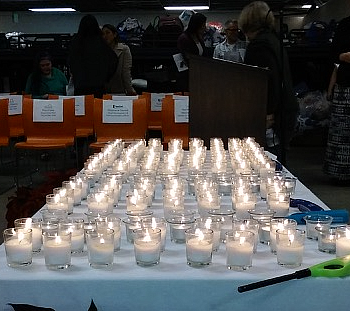In one of California’s most prosperous counties, homeless deaths keep mounting

One by one, elected officials and others stepped somberly to the microphone in a sparse and cheerless shelter in San Jose to read the names of the dead.
Michael Guilford. Dean Rowland. John Doe were just a few of them.
More than 160 names were read and after each, a bell tolled and a tealight was lit to remember them.
Some readers cried. The audience was quiet.
“They will be lights in our heart,” said Melanie Harrell, a board member of HomeFirst Santa Clara County, which provides shelter, services and housing opportunities to people who are homeless and at risk of becoming homeless.
Harrell lives in the downtown core of San Jose, Santa Clara County’s largest city, and wants to be part of the solution, she said at the gathering to remember the 161 people who died homeless in the county in 2019.
Nearly 1,300 of the county’s homeless died between the new millennium and the end of 2018.
More than 1,000 were men. And in many cases, they died from causes related to drugs or alcohol.
Guilford died from heroin intoxication at 52. Rowland from a combination of drugs and alcohol at 55 years old, and the unidentified John Doe of complications from chronic alcohol abuse.
They died young. Doctors say and the data show that people die about 25 years younger, on average, when they’re homeless than when they’re housed. That means the end is near at 52 or 53 years old.
Many remain nameless even though their names are recorded by the medical examiner.
Harrell said of the homeless who die, “So many people in our community are forgotten. They’re friends of ours.”
Of the 1,286 who died homeless over an 18-year period, 1,088 were described as male and 194 were female. One was described as “unknown” and the gender of three was listed as not available.
Alcohol and/or drugs were the main causes of death in at least 38.5% of the cases. Of those deaths, the numbers are split about evenly between alcohol and drugs, such as methamphetamine, opiates, cocaine and morphine.
Nearly 10,000 people are homeless in Santa Clara County, according to a point-in-time count, and at the end of the year the county had fewer than 1,000 shelter beds. The difference is the greatest among the nine Bay Area counties.
To help address the problem in Santa Clara County, California Gov. Gavin Newsom is making at least $45.9 million of emergency homeless aid available to the county to address homelessness there, one of the most prosperous areas in the state, considering it’s part of Silicon Valley. Statewide, $650 million will be available by the governor to cities and counties to help solve the problem.
Hope is not lost. Many who become homeless escape the condition within a year.
Daniel Flaming, president of the Economic RoundTable, which has done at least one study on homelessness in the Bay Area, said that with help, a majority of homeless people are able to get back on their feet in less than a year, but some get stuck.
“That’s really the face of homelessness,” he said, so it’s important to help people soon after their crisis sets in.
How they died, how that impacts the health of their families, friends and the larger community and what will help keep them alive will be the focus of my 2020 Center for Health Journalism California Fellowship. I’m grateful and thrilled to be a part of the 2020 class of fellows and look forward to listening and brainstorming with others in March.

